
The Economy
Bhutanese currency is Ngultrum (Nu) equivalent to Indian Rupee. There are ATMs in Bhutan and MasterCard is accepted, and credit cards are accepted only at selected shops. One can exchange money at Paro International Airport on arrival or any other Govt, also get help from your tour operator.
Though Bhutanese economy is one of the worlds smallest, it has grown rapidly in recent years. This was mainly due to the commissioning of the gigantic Hydroelectricity Project.
Bhutanese economy is based on agriculture, forestry, tourism and the sale of hydroelectric power to India. Agriculture provides the main livelihood for more than 80 percent of the population.
The industrial sector is in a nascent stage, and though most production comes from cottage industry, larger industries are being encouraged and some industries such as cement, steel, and Ferro alloy have been set up. Most development projects, such as road construction, rely on Indian contract labor. Agricultural produce includes rice, chilies, dairy (some yak, mostly cow) products, buckwheat, barley, root crops, apples, and citrus and maize at lower elevations. Industries include cement, wood products, processed fruits, alcoholic beverages and calcium carbide.




